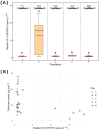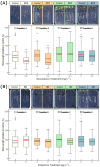Resistance to Amino Acid Biosynthesis Inhibiting-Herbicides in Amaranthus palmeri Populations from Aragon (Spain)
- PMID: 40431070
- PMCID: PMC12115111
- DOI: 10.3390/plants14101505
Resistance to Amino Acid Biosynthesis Inhibiting-Herbicides in Amaranthus palmeri Populations from Aragon (Spain)
Abstract
Amaranthus palmeri is a highly problematic agricultural weed due to its rapid growth, high seed production, and strong tendency to develop herbicide resistance. In Spain, the initial colonization of A. palmeri began in 2007, when populations were detected at various locations in the province of Lleida (Catalonia). Since then, new infestations have been reported in other regions of the country, primarily infesting maize fields. Although resistance to glyphosate or to acetolactate synthase (ALS) inhibitors has been documented in several populations from Catalonia and Extremadura, little is known about the resistance profile of populations from Aragon. The main objective of this study was to characterize the putative resistance of five populations from Aragon to 5-enolpyruvylshikimate-3-phosphate synthase (EPSPS) inhibitors (glyphosate) and ALS inhibitors (nicosulfuron and imazamox). Sensitivity to both mechanisms of action was measured by root growth in vertical plates and shikimate accumulation for glyphosate. Target-site resistance was evaluated by analyzing EPSPS and ALS gene copy numbers and ALS gene mutations. The populations showed high variability, with no multiple resistance detected. The Bujaraloz population showed moderate resistance to glyphosate due to EPSPS gene amplification. In three populations, mutations in the ALS gene conferring resistance were detected. The Trp574Leu mutation was detected in approximately half of the individuals from the Albelda, Tamarite de Litera, and Caspe populations. In the latter, the Pro197Thr mutation was also present. This study reveals significant genetic variability within each population and provides evidence for the spread of herbicide resistance across different regions of Spain.
Keywords: ALS mutation; EPSPS gene amplification; glyphosate; imazamox; nicosulfuron; target-site.
Conflict of interest statement
The authors declare no conflicts of interest.
Figures






Similar articles
-
Primary metabolism in an Amaranthus palmeri population with multiple resistance to glyphosate and pyrithiobac herbicides.Plant Sci. 2022 May;318:111212. doi: 10.1016/j.plantsci.2022.111212. Epub 2022 Feb 9. Plant Sci. 2022. PMID: 35351301
-
Multiple mutations in the EPSPS and ALS genes of Amaranthus hybridus underlie resistance to glyphosate and ALS inhibitors.Sci Rep. 2020 Oct 19;10(1):17681. doi: 10.1038/s41598-020-74430-0. Sci Rep. 2020. PMID: 33077813 Free PMC article.
-
Confirmation of herbicide resistance mutations Trp574Leu, ΔG210, and EPSPS gene amplification and control of multiple herbicide-resistant Palmer amaranth (Amaranthus palmeri) with chlorimuron-ethyl, fomesafen, and glyphosate.PLoS One. 2019 Mar 26;14(3):e0214458. doi: 10.1371/journal.pone.0214458. eCollection 2019. PLoS One. 2019. PMID: 30913269 Free PMC article.
-
Deciphering the Mechanism of Glyphosate Resistance in Amaranthus palmeri by Cytogenomics.Cytogenet Genome Res. 2021;161(12):578-584. doi: 10.1159/000521409. Epub 2022 Jan 12. Cytogenet Genome Res. 2021. PMID: 35021177 Review.
-
Glyphosate Resistance and EPSPS Gene Duplication: Convergent Evolution in Multiple Plant Species.J Hered. 2018 Feb 14;109(2):117-125. doi: 10.1093/jhered/esx087. J Hered. 2018. PMID: 29040588 Review.
References
-
- Moore J.W., Murray D.S., Westerman R.B. Palmer amaranth (Amaranthus palmeri) effects on the harvest and yield of grain Sorghum (Sorghum bicolor) Weed Technol. 2004;18:23–29. doi: 10.1614/WT-02-086. - DOI
-
- Ward S.M., Webster T.M., Steckel L.E. Palmer amaranth (Amaranthus palmeri): A review. Weed Technol. 2013;27:12–27. doi: 10.1614/WT-D-12-00113.1. - DOI
Grants and funding
LinkOut - more resources
Full Text Sources
Miscellaneous

